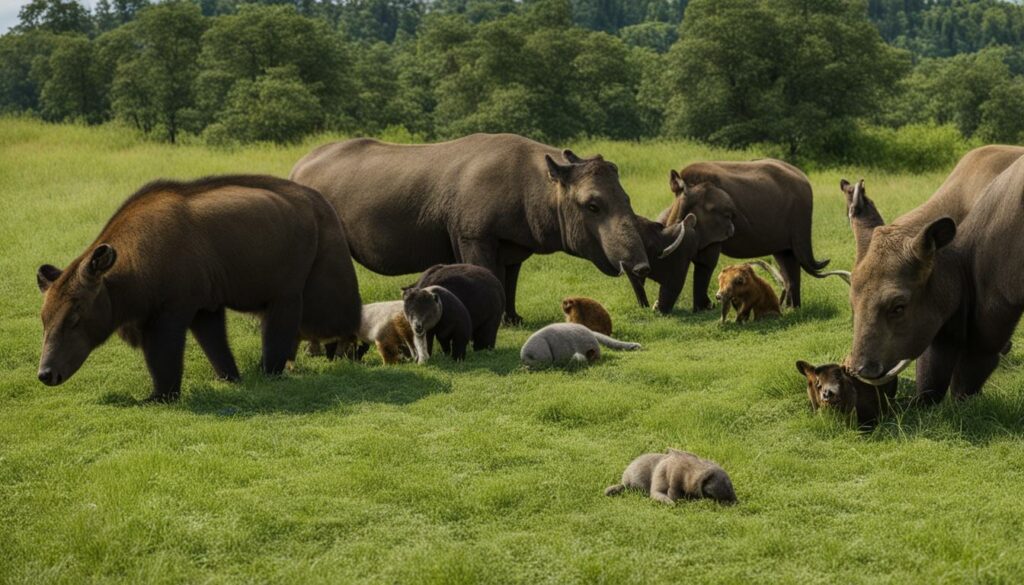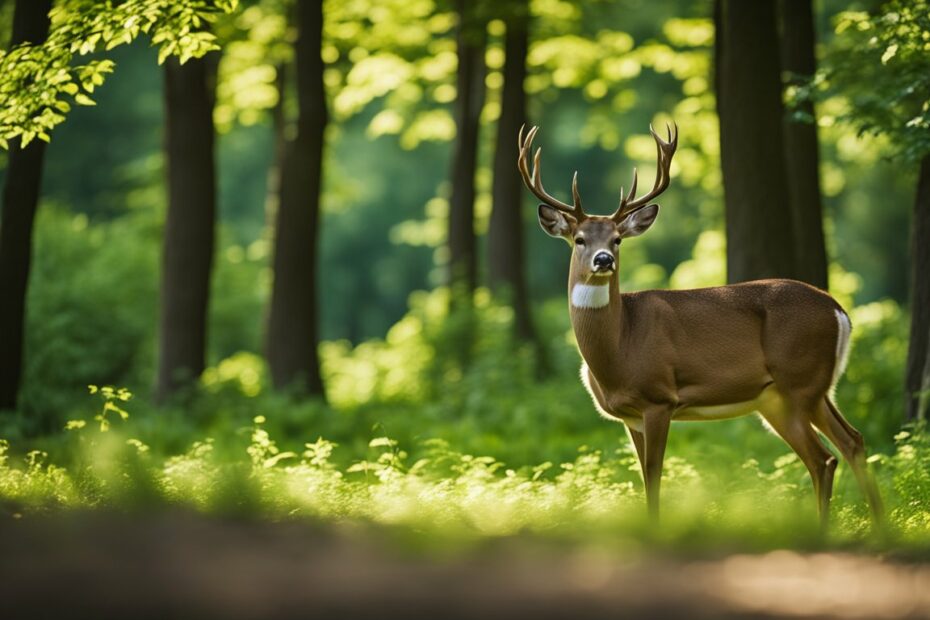Welcome to our in-depth exploration of deer digestive habits. This article aims to answer the question: “Do deer chew cud?” We will delve into the intricacies of rumination, the cud-chewing process, and the overall digestion of deer.
As herbivores, deer predominantly feed on plant material, which requires specialized digestive mechanisms to extract nutrients efficiently. The cud-chewing process is central to the digestion of deer, ensuring optimal absorption of nutrients from their plant-based diet.
Do Deer Chew Cud?
Cud-chewing is a characteristic behavior observed in ruminant animals, including deer. When deer graze on vegetation, they quickly swallow the food without chewing it properly. This partially chewed food enters the stomach’s first chamber, the rumen. The food mixes with the rumen microbes and forms a cud mass.
After some time, the deer regurgitates the cud back into its mouth, thoroughly chewed, and mixed with saliva. This process further breaks down the plant material, improving nutrient extraction.
The Unique Digestive System of Deer
The digestive system of a deer consists of several important organs, including the mouth, esophagus, stomach, and intestines. Each of these organs plays a crucial role in the digestion and absorption of nutrients from plant material.
Deer have specialized teeth that are adapted for chewing their food. Their molars have ridges and cusps that help break down tough and fibrous plant material. The chewing motion of deer is vital in increasing the surface area of their food, allowing for better digestion.
Furthermore, the deer’s stomach comprises four chambers, each with its function in the digestion process. These chambers work together to break down plant material and extract nutrients.
The first chamber, known as the rumen, is where fermentation of cellulose occurs, with the help of bacteria and other microorganisms.
Deer also have a unique process called rumination or cud-chewing. After initial ingestion, food is stored in the rumen and later regurgitated to be chewed again. This process allows for thorough breakdown and extraction of nutrients from the plant material.
Rumination: A Vital Process for Deer Nutrition
Rumination, or the process of cud-chewing, is crucial for deer nutrition. The prolonged chewing also helps to increase the surface area of the food, allowing for better microbial digestion.
Additionally, rumination enables deer to extract more energy from their food and maintain a balanced diet. The thorough breakdown of cellulose in the cud releases volatile fatty acids, which serve as an essential energy source for deer.

The Role of Microorganisms in Digestion
Microorganisms play a vital role in the digestion process of deer. Within the rumen, these microorganisms break down cellulose, a complex carbohydrate in plant cell walls. Deer lack the enzymes necessary to digest cellulose on their own, making the presence of these microorganisms essential for their digestion.
The microorganisms in deer’s digestive system utilize a fermentation process to break down cellulose and release nutrients. This symbiotic relationship between deer and the microorganisms in their rumen allows for the efficient extraction of nutrients from their plant-based diet.
Mechanisms of Digestion in Deer |
|
|---|---|
| Feeding Behavior | Deer are selective feeders, consuming a wide variety of vegetation. They browse leaves, twigs, and fruit, adapting their feeding behavior based on plants’ availability and nutritional content. |
| Rumen Fermentation | The rumen is the primary fermentation site, where the microorganisms break down cellulose and other complex carbohydrates. This process releases volatile fatty acids that serve as an energy source for deer. |
| Cud-Chewing Process | After swallowing partially chewed food, deer bring it back up to their mouth as cud. They thoroughly chew the cud, allowing for a better breakdown of plant material and nutrient extraction. |
| Microbial Digestion | The microorganisms in the deer’s rumen aid in the breakdown of cellulose through fermentation. This process releases nutrients that the deer can absorb and utilize. |
Deer Anatomy and Diet: Adaptations for Digesting Cellulose
Deers have a specialized dental anatomy well-suited for their chewing behavior and diet. Their teeth are designed to efficiently grind down and break apart plant material, allowing for better digestion and nutrient absorption. Let’s take a closer look at the different types of teeth found in a deer’s mouth:
- Incisors: Located at the front of the mouth, incisors help in grasping and biting off vegetation.
- Canines: Deer typically lack well-developed canines, as their diet consists mainly of plant material.
- Premolars and Molars: These teeth grind and crush fibrous plant matter. The molars, in particular, have large, flat surfaces that aid in the breakdown of cellulose.
Deer’s chewing behavior plays a crucial role in their digestive process. They are known as “hindgut fermenters,” meaning that after they chew and swallow their food, it enters the first chamber of their stomach, known as the “rumen.” Here, the partially digested food undergoes fermentation before regurgitating and re-chewing to break down complex plant fibers further.
How Deer Stomach Compartments Facilitate Digestion
Deer have complex stomachs comprising four compartments, each with a unique digestion function. These compartments work together to maximize the extraction of nutrients from plant material:
- Rumen: The rumen is the largest compartment and serves as a fermentation vat. It houses billions of microorganisms, including bacteria and protozoa, that help break down cellulose through fermentation.
- Reticulum: The reticulum acts as a collection chamber for heavy particles and aids in regurgitation.
- Omasum: The omasum acts as a filtration system, removing excess water and absorbing nutrients from the partially digested food.
- Abomasum: The abomasum is a deer’s “true stomach” and functions similarly to the stomach in monogastric animals. It secretes digestive enzymes that further break down the food before it moves into the intestines for absorption.
Exploring the Four-Chambered Stomach of a Deer
The four chambers of a deer’s stomach are:
- The Rumen: This chamber is responsible for the initial breakdown of plant material through fermentation. It contains many microorganisms that help break down cellulose and release volatile fatty acids.
- The Reticulum: Also known as the “honeycomb,” this chamber acts as a filter, trapping larger food particles and regurgitating them back into the mouth for further chewing.
- The Omasum: Often referred to as the “manyplies,” this chamber is responsible for the absorption of water and the extraction of micronutrients from processed food.
- The Abomasum: This chamber is functionally similar to the stomach of monogastric animals, secreting gastric juices that further break down the food into more digestible components.
The Fermentation Process: Breaking Down the Plant Material
During fermentation, microorganisms in the deer’s digestive system break down complex carbohydrates and fiber into simpler substances that can be easily absorbed. This process occurs in a specialized chamber of the deer’s stomach, the rumen.
Fermentation and Methane Production in Deer
One notable byproduct of fermentation in deer is the production of methane gas. As the plant material is broken down by the microorganisms in the rumen, methane is released as a result. This methane production has significant environmental implications, as methane is a potent greenhouse gas.
It is estimated that deer contribute to methane emissions through their fermentation process. However, the extent of this contribution is still being studied. Understanding the balance between deer populations and methane production is crucial for mitigating the environmental impact.
The Link Between Deer’s Feeding Habits and Their Digestive Health
The feeding habits of deer play a vital role in their digestive health. Deer are herbivores and have evolved to consume diverse plant material. However, sudden changes in diet or the consumption of low-quality forage can negatively impact their digestive system.
Deers must have a consistent and balanced diet to maintain optimal digestive health. A fiber-rich diet allows the fermentation process to occur correctly, ensuring efficient nutrient absorption. Access to clean water is also essential for proper digestion and overall well-being.
| Feeding Habits | Impact on Digestive Health |
|---|---|
| Diverse diet with high-quality forage | Promotes healthy fermentation process and nutrient absorption |
| Poor-quality forage or sudden dietary changes | Can disrupt the digestive system and lead to digestive issues |
| Adequate access to clean water | Essential for proper digestion and overall well-being of deer |
Deer’s Nutritional Needs and the Efficiency of Their Digestive Process
Deer have a specialized system that enables them to absorb water from the plants they consume efficiently. This is crucial for maintaining hydration and overall health.
The Importance of Water Absorption and Nutrient Uptake
Water absorption plays a vital role in deer’s digestion. As herbivores, deer primarily consume plant material, often low in moisture. Deers have developed a large digestive system for extended food retention to compensate for this.
This enables efficient water absorption from the ingested plant material, ensuring that deer stay hydrated even in dry environments.
Additionally, the digestive process in deer is optimized for nutrient uptake. Deer rely on a series of fermentation chambers in their stomach, where microorganisms break down the cellulose found in plants.
This process releases essential nutrients that the deer’s intestinal lining can absorb. These nutrients include carbohydrates, proteins, and fatty acids for deer to thrive.
Regurgitation and Re-digestion: Maximizing Energy and Nutrients
A fascinating aspect of deer’s digestive process is their ability to regurgitate and re-digest their food. This unique adaptation allows them to extract more energy and nutrients from their diet.
After initially ingesting their food, deer can bring partially digested material back into their mouth for further chewing.
This process, known as rumination, not only improves the breakdown of cellulose but also increases the absorption of nutrients.
